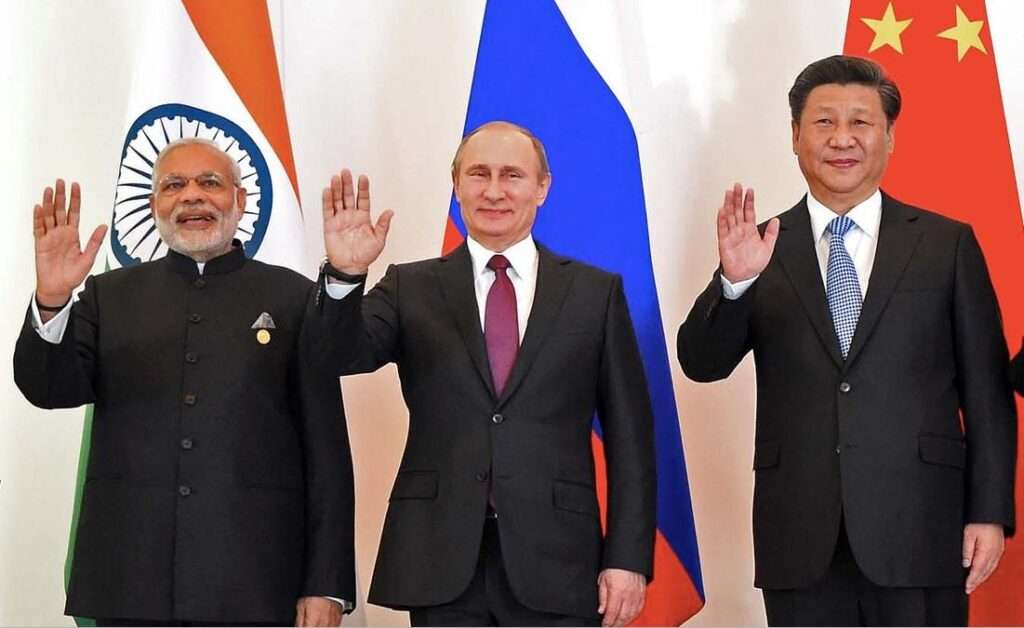The Russia-India-China (RIC) trilateral mechanism, in a world increasingly marked by fragmented alliances and polarised geopolitics, is both, an enduring concept and a diplomatic puzzle. RIC, which is a mechanism in response to U.S. unipolar dominance and claim for a multipolar world order, which fundamentally adheres to the principles of sovereignty, mutual respect, and strategic autonomy, was formed by Russian strategist, Yevgeny Primakov, in the late 1990s.
Over 20 years later, the mechanism still exists even if not always kicking. While India attended a RIC Foreign Ministers’ Meeting in July 2023 and China advocated trilateral cooperation in BRICS+ spaces, the dialogue has not been reduced to nothing. However, nations are evolving operationally and geopolitically at such a pace that the three nation-states are operating in disparate frameworks, leaving RIC to be both a representation of something that had potential, and a casualty of circumstance.
Origin of multipolar vision
At its most basic, RIC was conceived as a soft-power venue in which the three Eurasian giants, which together account for almost 40% of the world’s population and a GDP more than $21 trillion (2024), could engage on global issues together and on a equal footing. Concerns over terrorism, energy security, governance of the global commons, and development provided for the perfect overlap for the cooperation between the three nations.
India saw RIC as an opportunity to anchor its strategic autonomy, to balance its growing ties with the West, while maintaining stronger engagement with Moscow and Beijing. Russia saw it to navigate the geopolitical environment in order not to be hemmed in by NATO and at the same time, not become overly reliant on China. For China, RIC represented an opportunity for a measure of legitimacy for its multipolar vision without the obligation of leading a formal alliance.
The Weakness of RIC: India-China Mistrust
Although RIC was launched with fine hopes, it has struggled from the very beginning because of a perpetual fault line: the India-China rivalry. The 2020 clash in the Galwan Valley, where 20 Indian soldiers and an unknown number of Chinese soldiers were killed, undermined trust even further between India and China. Armed clashes, military standoffs and diplomatic frosts along the Line of Actual Control (LAC) have been the norm rather than the exception since the Galwan clash.
India has been publicly critical of China’s Belt and Road Initiative (BRI) and has openly opposed the China-Pakistan Economic Corridor (CPEC) that runs through contested territory in Jammu and Kashmir. China, for its part, has repeatedly blocked India’s attempts at the United Nations to have Pakistan-based terrorists blacklisted, greasing the diplomatic slope.
Russia in the Middle: Balancing Act Between Allies
Amidst these tensions, Russia is attempting to walk a fine line. Historically, Moscow has had the closest strategic relationship with India. However, the increasing economic and defence ties that Russia has had with Beijing which has grown exponentially following Moscow’s 2022 invasion of Ukraine and the ensuing Western-sanctioned decline of the Russian economy raises concern in New Delhi. As of 2024, trade between Russia and China amounted to more than $240 billion dollars with China purchasing at a discount Russian oil and gas, along with Moscow’s increasing dependence upon Chinese technological and banking systems. At the same time, India continues to be the largest consumer of Russian arms, and it engaged in bilateral trade with Russia of approximately $65 billion dollars in FY 2023–24, primarily attributable to energy purchases. Russia’s strategic intent is to not take sides. Russia continues to support BRICS and SCO venues which are membered by both India and China and pursues multilateralism as a sympathetic venue to avoid troubling bilateral issues.
Why RIC Still Resonates or Might
The RIC mechanism is not completely dead, despite the odds against it. In a fractured, chaotic global order, RIC is useful as second-tier dialogues incorporating track-two diplomacy and consensus-building, particularly as it relates to global issues such as climate change, artificial intelligence regulation, developing multinational frameworks against terrorism and organizations like the UN. Additionally, considering that India will become the third-largest economy in the world by 2027, China will emerge as an unregulated tech-superpower and Russia remains a significant player in terms of energy and defence, trilateral engagement should still have strategic reasoning, if not synergy.
New Delhi’s recent restrained response to Russia’s war in Ukraine; India’s membership in the BRICS bank led by China, suggests that India still sees room, diplomatically, for autonomy, pragmatism and a RIC approach. If RIC (Russia-India-China) is to be more than a symbolic grouping, it must address the most pressing item on its agenda: the differing levels of trust between India and China. The two countries need to build trust to work on minor issues together, for example, non-controversial areas such as health or digital rules and consistently exclude areas of disagreement from RIC meetings. This will make RIC more valuable as a grouping.
At a time when maker alliances and global governance seem more rigid, RIC’s greatest asset may lie in being more open and flexible. It does not need to pursue either full alignment or unity, but it can be a forum for the three countries to talk and interact, even if they do not always do so with mutual agreement. If it does not consist of a tight partnership, it can still allow for discussion among three countries.
Frequently Asked Questions (FAQ’s):
1. What is the purpose of the Russia-India-China (RIC) trilateral mechanism?
The RIC aims to promote multipolarity, strategic autonomy, and cooperation on global issues like terrorism, energy security, and governance.
2. Why has RIC struggled to achieve its potential?
The primary challenge has been deep mistrust between India and China, fueled by border clashes, BRI disagreements, and geopolitical rivalry.
3. Why does RIC still matter today?
Despite tensions, RIC offers a forum for dialogue, consensus-building, and cooperation on non-controversial global issues like climate, technology, and UN reforms.

